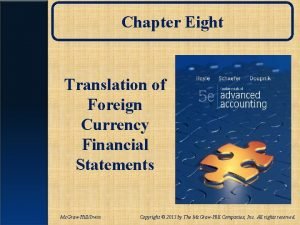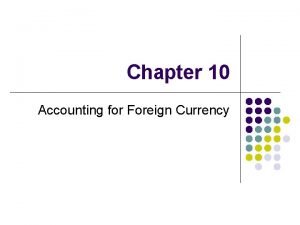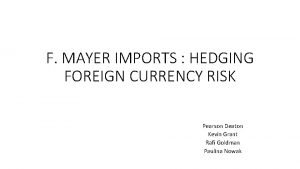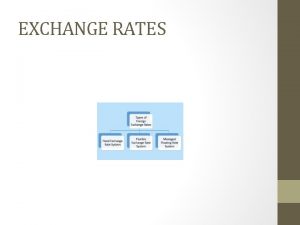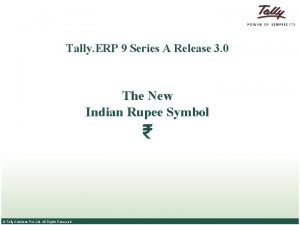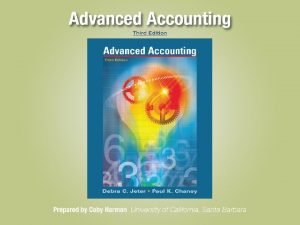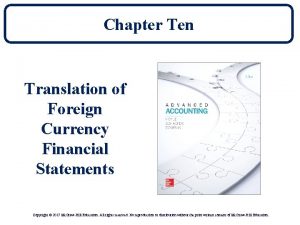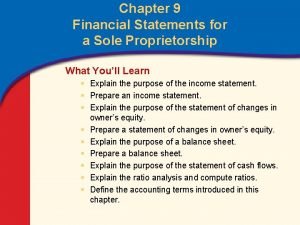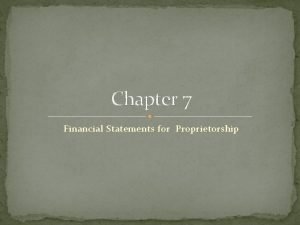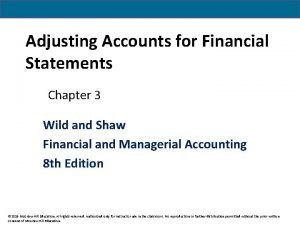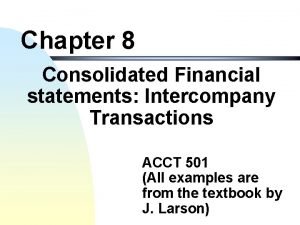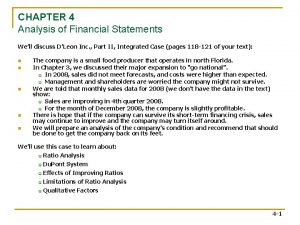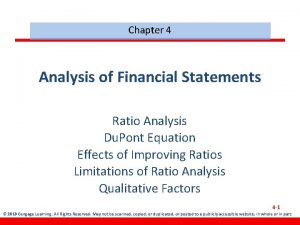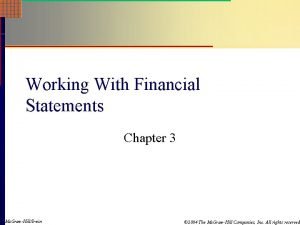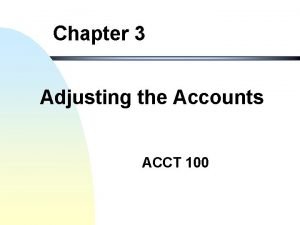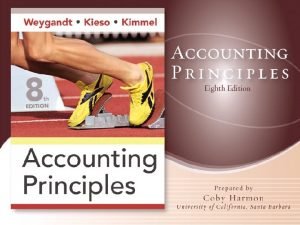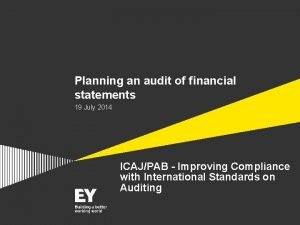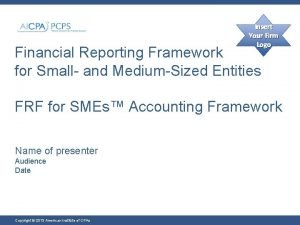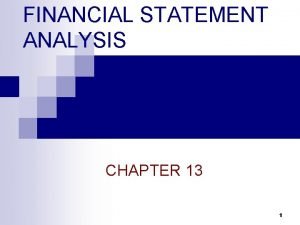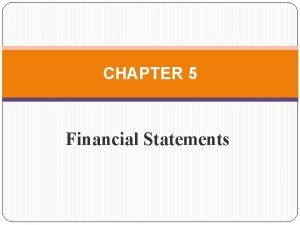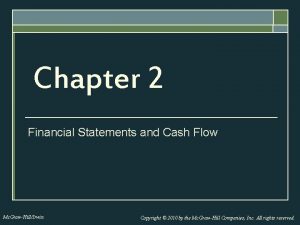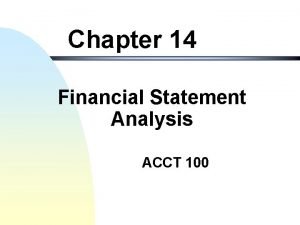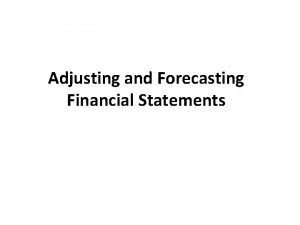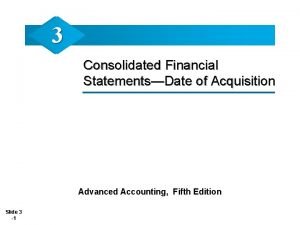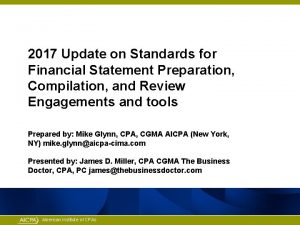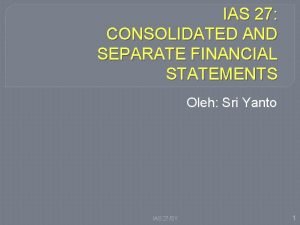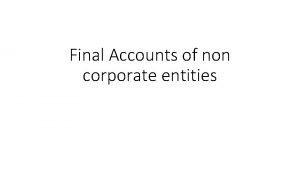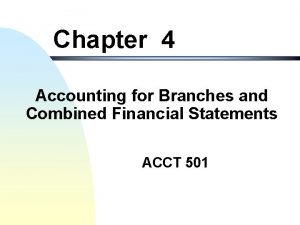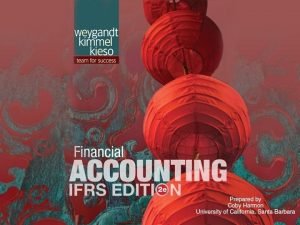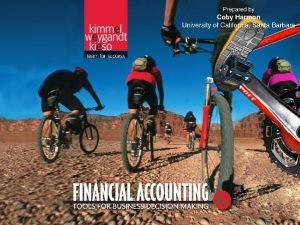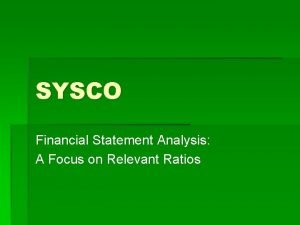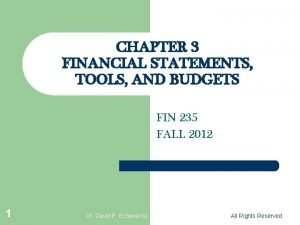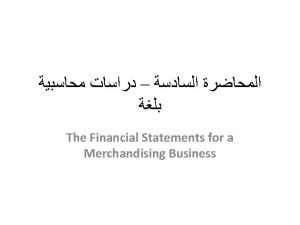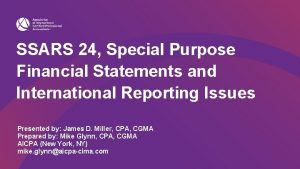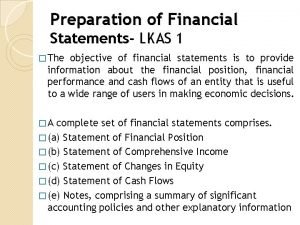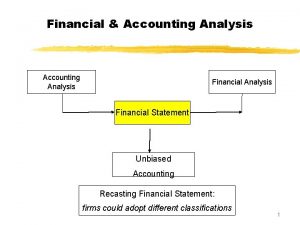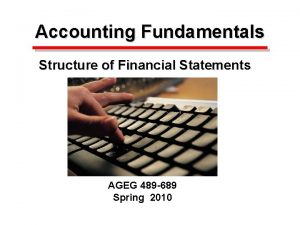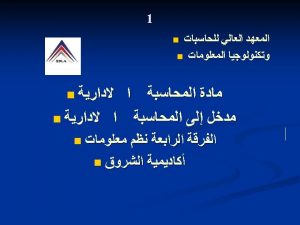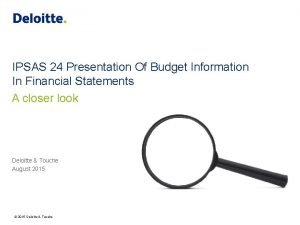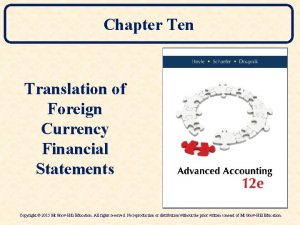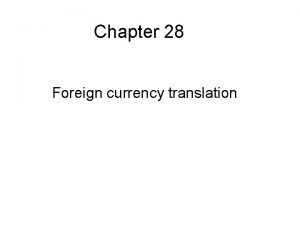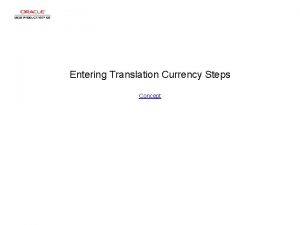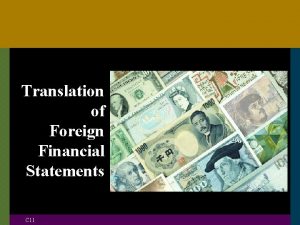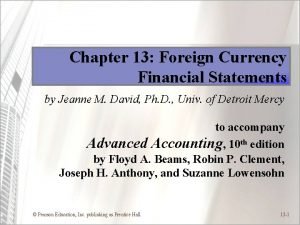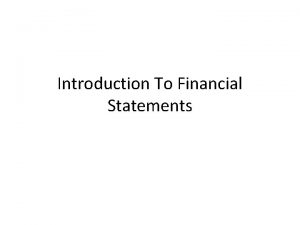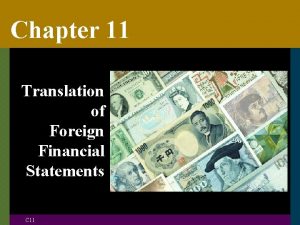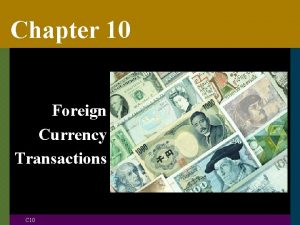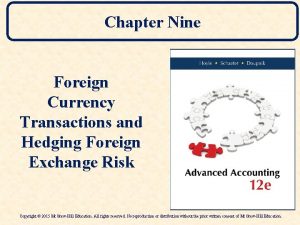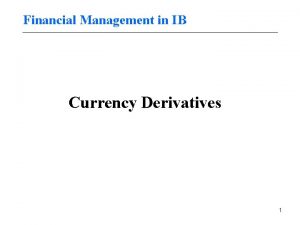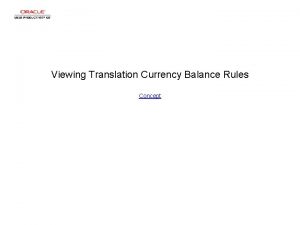Chapter 10 Translation Of Foreign Currency Financial Statements

























































- Slides: 57

Chapter 10 Translation Of Foreign Currency Financial Statements © 2008 Clarence Byrd Inc. 1

Basic Issues l Selecting the appropriate method of translation l For transactions: the temporal method l For statements: temporal or current rate © 2008 Clarence Byrd Inc. 2

Basic Issues l Treatment of exchange gains and losses l For transactions: Immediately to Net Income l For statements: To Net or Comprehensive Income © 2008 Clarence Byrd Inc. 3

Accounting Principles l Use of foreign principles reflects conditions in the foreign economic and legal environment l Use of Canadian principles maintains consistency of application © 2008 Clarence Byrd Inc. 4

Accounting Principles l CICA conclusion: Statements must be adjusted to reflect Canadian GAAP l Will not be an issue after changeover to IFRSs © 2008 Clarence Byrd Inc. 5

Classification - CICA l Integrated Foreign Operation: A foreign operation that is financially or opera tionally o interdependent with the reporting enterprise such that the exposure to exchange rate changes is similar to the exposure that would exist had the transactions and activities of the foreign operation been undertaken by the reporting enterprise. A foreign subsidiary that raises its capital in Canadian markets, purchases its merchandise or other goods in Canadian markets, and/or sells its goods in Canadian markets. © 2008 Clarence Byrd Inc. 6

Classification - CICA l Self-Sustaining Foreign Operation: Selfsustaining foreign operation — A foreign operation that is financially and operationally independent of the reporting enterprise such that the exposure to exchange rate changes is limited to the reporting enterprise's net investment in the foreign operation. A foreign subsidiary that raises its capital in the foreign market, purchases its merchandise or other goods in the foreign market, and/or sells its goods in the foreign market. © 2008 Clarence Byrd Inc. 7

Factors To Consider In Classification – 1651. 10 l (a) there any factors which would indicate that the cash flows of the reporting enterprise are insulated from or are directly affected by the day-to-day activities of the foreign operation; l (b) sales prices for the foreign operation’s products or services are determined more by local competition and local government regulations or more by world-wide competition and international prices and whether such sales prices are primarily responsive on a short-term basis to changes in exchange rates or are immune to such changes; © 2008 Clarence Byrd Inc. 8

Factors To Consider In Classification – 1651. 10 l (c) the sales market for the foreign operation’s products and services is primarily outside the reporting enterprise’s country or within it; l (d) labor, materials and other costs of the foreign operation’s products or services are primarily local costs or whether the foreign operation depends on products and services obtained primarily from the country of the reporting enterprise; © 2008 Clarence Byrd Inc. 9

Factors To Consider In Classification – 1651. 10 l l (e) the day-to-day activities of the foreign operation are financed primarily from its own operations and local borrowings or primarily by the reporting enterprise or borrowings from the country of the reporting enterprise; (f) there is very little interrelationship between the dayto-day activities of the foreign operation and those of the reporting enterprise or whether intercompany transactions with the reporting enterprise form a dominant part of the foreign operation’s activities. © 2008 Clarence Byrd Inc. 10

Classification – IAS No. 21 l Functional Currency is the currency of the primary economic environment in which the entity operates. © 2008 Clarence Byrd Inc. 11

Classification – IAS No. 21 l Paragraph 9 The primary economic environment in which an entity operates is normally the one in which it primarily generates and expends cash. An entity considers the following factors in determining its functional currency: l (a) the currency: l l l (i) that mainly influences sales prices for goods and services (this will often be the currency in which sales prices for its goods and services are denominated and settled); and (ii) of the country whose competitive forces and regulations mainly determine the sales prices of its goods and services. (b) the currency that mainly influences labour, material and other costs of providing goods or services (this will often be the currency in which such costs are denominated and settled). © 2008 Clarence Byrd Inc. 12

Classification - IAS No. 21 l functional currency is the reporting currency (e. g. , a Foreign operations for which the company that reports in Canadian dollars and has a foreign subsidiary for which the functional currency is the Canadian dollar). A foreign subsidiary that raises its capital in Canadian markets, purchases its merchandise or other goods in Canadian markets, and/or sells its goods in Canadian markets. © 2008 Clarence Byrd Inc. 13

Classification - IAS No. 21 l Foreign operations for which the functional currency is different from the reporting currency (e. g. , a company which reports in Canadian dollars and has a German subsidiary for which the functional currency is the euro). A foreign subsidiary that raises its capital in the foreign market, purchases its merchandise or other goods in the foreign market, and/or sells its goods in the foreign market. © 2008 Clarence Byrd Inc. 14

Classification – The Future l The integrated/selfsustaining approach is a conceptually flawed solution l It will disappear with the changeover © 2008 Clarence Byrd Inc. 15

Translation Method Integrated Foreign Operations l Paragraph 1651. 07 For integrated foreign operations, the reporting enterprise's exposure to exchange rate changes is similar to the exposure that would exist had the transactions and activities of the foreign operation been undertaken by the reporting enterprise. Therefore, the financial statements of the foreign operation are expressed in a manner that is consistent with the measurement of domestic transactions and operations. The translation method that best achieves this objective is the temporal method, because it uses the Canadian dollar as the unit of measure. © 2008 Clarence Byrd Inc. 16

Application of the Temporal Method l Expenses and Revenues l Generally at average rates l Assumes the item occurred uniformly over the period l Assumes the rate changed uniformly over the period © 2008 Clarence Byrd Inc. 17

Application of the Temporal Method l Amortization Expense l. A write-off of items carried at historical cost l at historic rates © 2008 Clarence Byrd Inc. 18

Application of the Temporal Method l Cost Of Sales l Opening inventory at historic l Purchases l Closing © 2008 Clarence Byrd Inc. at average inventory at historic 19

Application of the Temporal Method l Sales of Capital Assets l Proceeds at current rate on transaction date l Cost at historical rate from acquisition date © 2008 Clarence Byrd Inc. 20

Translation Method Self-Sustaining Foreign Operation l Paragraph 1651. 08 For self-sustaining foreign operations, the reporting enterprise's exposure to exchange rate changes is limited to its net investment in the foreign operation. Therefore, measuring such operations as if they had carried out their activities in Canadian dollars is considered to be less relevant than measuring the overall effect of changes in the exchange rate on the net investment in such operations. The financial statements of the foreign operation are expressed in Canadian dollars in a manner that does not change the financial results and relationships of the foreign operation. The translation method that best achieves this objective is the current rate method, because it uses the currency of the foreign operation as the unit of measure. © 2008 Clarence Byrd Inc. 21

Current Rate Method l The current rate method is a method of translation that translates assets, liabilities, revenues and expenses in a manner that retains their bases of measurement in terms of the foreign currency (i. e. , it uses the foreign currency as the unit of measure). In particular: l l assets and liabilities are translated at the exchange rate in effect at the balance sheet date; revenue and expense items (including depreciation and amortization) are translated at the exchange rate in effect on the dates on which such items are recognized in income during the period. © 2008 Clarence Byrd Inc. 22

Current Rate Method Shareholders’ Equity l Accumulated Other Comprehensive Income This account will contain the net exchange gain or loss that has resulted from the translation of assets and liabilities since the acquisition of the foreign operation. This amount can be either positive (a net gain) or negative (a net loss) with respect to the total shareholders’ equity balance. © 2008 Clarence Byrd Inc. 23

Current Rate Method Shareholders’ Equity l Retained Earnings This balance will reflect the cumulative translated income of the foreign operation, exclusive of exchange gains and losses and reduced by dividends declared. © 2008 Clarence Byrd Inc. 24

Current Rate Method Shareholders’ Equity l Common Shares As all of the exchange gains and losses have been allocated to Accumulated Other Comprehensive Income, the contributed capital account, Common Shares, will have to be translated at the historic exchange rate applicable to its issue date. This seeming anomaly is the only approach that will produce a total Shareholders’ Equity that equals the difference between assets and liabilities when these balances are translated at current rates. It is likely that you will have a better grasp of this point after you have worked through the comprehensive example that is presented later in this Chapter. © 2008 Clarence Byrd Inc. 25

Why The Current Rate Method Example On January 1, 2008, when € 1 = $1. 40, a Canadian company established a subsidiary with an investment of € 200, 000. The subsidiary borrows € 800, 000 and invests the € 1, 000 in Land. On December 31, 2008, € 1 = $1. 50. © 2008 Clarence Byrd Inc. 26

Why The Current Rate Method Balance Sheets December 31, 2008 Temporal Current Rate Land (@ $1. 40 & $1. 50 $1, 400, 000 $1, 500, 000 Liabilities (@ $1. 50) $1, 200, 000 300, 000 $1, 400, 000 $1, 500, 000 Shareholders’ Equity (Residual) Total Equities The current rate method maintains economic relationships (e. g. , debt is still 20 percent of the total equities. © 2008 Clarence Byrd Inc. 27

Highly Inflationary Economies l Current rate method uses foreign currency as unit of measure l Not good if highly inflationary economy l Use temporal method for self-sustaining © 2008 Clarence Byrd Inc. 28

Exchange Gains And Losses Integrated Operations l Paragraph 1651. 20 An exchange gain or loss of the l Paragraph 1651. 24 Exchange gains and losses reporting enterprise that arises on translation or settlement of a foreign currency-denominated monetary item or a non-monetary item carried at market should be included in the determination of net income for the current period. (January, 2002) arising on the translation of financial statements of an integrated foreign operation should be accounted for in accordance with paragraph 1651. 20. (July, 1983) © 2008 Clarence Byrd Inc. 29

Exchange Gains And Losses Self-Sustaining Foreign Operations l Paragraph 1651. 29 Exchange gains and losses arising from the translation of the financial statements of a self-sustaining foreign operation should be recognized in a separate component of other comprehensive income, except when the economic environment of the foreign operation is highly inflationary relative to that of the reporting enterprise, in which case such exchange gains and losses should be treated in accordance with paragraph 1651. 20. (October, 2006) © 2008 Clarence Byrd Inc. 30

Why The Difference? Example A French subsidiary of a Canadian company borrows € 1, 000 when the exchange rate is € 1 = $1. 40. This results in a translated value of $1, 400, 000. If the exchange rate goes to € 1 = $1. 50, the new translated value will be $1, 500, 000. © 2008 Clarence Byrd Inc. 31

Why The Difference? l If integrated foreign operation l Would have to use Canadian dollar revenues to buy Euros l There would be an exchange of currencies l This would result in a real economic loss © 2008 Clarence Byrd Inc. 32

Why The Difference l If self-sustaining foreign operation l Euro debt will be repaid with Euro revenues l There would be no exchange of currencies l There would be no real economic loss © 2008 Clarence Byrd Inc. 33

Reduction In Net Investment l Paragraph 1651. 31 An appropriate portion of the exchange gains and losses accumulated in the separate component of accumulated other comprehensive income should be included in the determination of net income when there is a reduction in the net investment. (October, 2006) © 2008 Clarence Byrd Inc. 34

Exchange Gain or Loss Integrated Operations Translated Amounts Opening Net Monetary Assets (Liabilities) Additions To Monetary Balances (e. g. , Sales) ($1, 500, 000) 4, 200, 000 Reductions In Monetary Balances (e. g. , Purchases) ( 2, 900, 000) Computed Closing Net Monetary Assets (Liabilities) ($ 200, 000) Actual Closing Net Monetary Assets (Liabilities) Exchange (Gain) Loss 300, 000 ($ 500, 000) *Numbers created for this example. Note exchange gain is a negative number in this schedule. © 2008 Clarence Byrd Inc. 35

Exchange Gain or Loss Self-Sustaining Operations Translated Amounts Opening Net Assets (Liabilities) ($2, 500, 000) Additions To Net Assets (e. g. , Sales) 4, 200, 000 Reductions In Net Assets (e. g. , Cost of Sales) ( 2, 400, 000) Computed Closing Net Assets (Liabilities) ($ 700, 000) Actual Closing Net Assets (Liabilities) ( Exchange (Gain) Loss 900, 000) $ 200, 000 *Numbers created for this example. Note exchange loss is a positive number in this schedule. © 2008 Clarence Byrd Inc. 36

Exchange Gain or Loss Difference in Calculation l Integrated Foreign Operations l Changes l in Net Monetary Assets Self Sustaining Foreign Operations l Changes © 2008 Clarence Byrd Inc. in Net Assets 37

Changes In Classification l Paragraph 1651. 36 When there are significant changes in the economic facts and circumstances that require the translation method applied to a particular foreign operation to be changed, the change in method should be accounted for prospectively. Disclosure should be made of the reasons for the change in the translation method. (July, 1983) © 2008 Clarence Byrd Inc. 38

Changes In Classification l Self-Sustaining To Integrated l l Accumulated OCI is carried forward Carrying values at time of change become the historical costs for items carried at historical value © 2008 Clarence Byrd Inc. 39

Changes In Classification l Integrated To Self-Sustaining l l At time of change all items to current rate Gain or loss to Accumulated OIC © 2008 Clarence Byrd Inc. 40

Disclosure l Paragraph 1651. 37 The amount of exchange gain or loss included in net income should be disclosed (see paragraphs 1651. 20, 1651. 24 and 1651. 31). An entity may exclude from this amount those exchange gains or losses arising on financial instruments classified as held for trading in accordance with "Financial Instruments — Recognition And Measurement", Section 3855. An entity may also exclude from this amount exchange gains or losses on available-for-sale financial assets and cash flow hedges (see "Hedges", Section 3865) included in any gains or losses removed from accumulated other comprehensive income and included in net income for the period. © 2008 Clarence Byrd Inc. 41

Equity Method Investments l Paragraph 1651. 38 The financial statements of a foreign investee accounted for by the equity method (see "Investments", Section 3051) are first translated into Canadian dollars in accordance with this Section; then the equity method is applied. © 2008 Clarence Byrd Inc. 42

Other Issues l Foreign operations with foreign currency transactions l Translate to foreign operations currency, generally using the temporal method l Foreign operations with foreign operations l Will have to classify and translate as appropriate © 2008 Clarence Byrd Inc. 43

Other Issues Intercompany Balances l Paragraph 1651. 41 With respect to integrated foreign operations, exchange gains and losses relating to intercompany balances recorded by the reporting enterprise or the foreign operation will be treated in the same manner as those relating to other foreign currency receivables or payables in accordance with paragraph 1651. 20 (i. e. , included in income). © 2008 Clarence Byrd Inc. 44

Other Issues Intercompany Balances l Paragraph 1651. 42 With respect to self-sustaining foreign operations, exchange gains and losses on intercompany account balances that are not included as part of the net investment are treated in the same manner as those relating to normal foreign currency trade balances in accordance with the appropriate requirements of this Section. Exchange gains and losses on intercompany account balances that form part of the net investment are recognized in the separate component of other comprehensive income in accordance with paragraph 1651. 29. © 2008 Clarence Byrd Inc. 45

Other Issues Intercompany Profits l Integrated operations l Use l transaction date rate Self-sustaining operations l Use transaction date rate © 2008 Clarence Byrd Inc. 46

Other Issues - Differences in Financial Statements Dates l Paragraph 1651. 44 When the date of the financial statements of the foreign operation differs from that of the reporting enterprise, those assets and liabilities which are translated at the current rate would normally be translated at the rate in effect at the balance sheet date of the foreign operation, not at the rate in effect at the balance sheet date of the reporting enterprise. When there is a major change in exchange rates between the balance sheet dates of the foreign operation and the reporting enterprise, the effect of the change would be disclosed. © 2008 Clarence Byrd Inc. 47

Other Issues Preference Shares l Integrated Operations l Use historic rate unless redemption is required or imminent l Self-Sustaining Operations l Use current rate © 2008 Clarence Byrd Inc. 48

Other Issues Lower of Cost and Market Example A French subsidiary has inventories purchased for € 500, 000 when the exchange rate was € 1 = $1. 55. At the Balance Sheet date, these inventories have a market value of € 525, 000. At this time € 1 = $1. 40 © 2008 Clarence Byrd Inc. 49

Other Issues Lower of Cost and Market Analysis The lower Euro figure is € 500, 000 cost. Translated cost = $775, 000 [(€ 500, 000)($1. 55)] Translated market = $735, 000 [(€ 525, 000)($1. 40)] On a translated basis, market is the lower figure. © 2008 Clarence Byrd Inc. 50

Other Issues Future Tax Assets and Liabilities l Paragraph 1651. 52 Future income tax liabilities and assets are monetary items and, as such, are translated at the current rate. © 2008 Clarence Byrd Inc. 51

Other Issues Cash Flow Statements l (a) Cash from operations would be translated at the exchange rate at which the respective items are translated for income statement purposes. l (b) Other items would be translated at exchange rates in effect when the related transactions took place. l (c) The effect of subsequent exchange rate changes on the cash flows during the period and on cash and cash equivalents at the commencement of the period would be disclosed, so that cash and cash equivalents at the end of the period are translated at the exchange rate in effect on that date. © 2008 Clarence Byrd Inc. 52

International Convergence IAS No. 21 – Effects Of Foreign Exchange Rates IAS No. 29 – Financial Reporting In Hyperinflationary Economies © 2008 Clarence Byrd Inc. 53

International Convergence: Differences Classification Of Foreign Operations Section 1651 classifies foreign operations as either integrated or self-sustaining. While the results are likely to be similar, IAS No. 21 classifies foreign operations on the basis of their functional currency. The appropriate accounting is then determined based on whether the functional currency is the reporting currency of the investor or, alternatively, the reporting currency of the foreign operation. © 2008 Clarence Byrd Inc. 54

International Convergence: Differences Non-Monetary Items Carried At Fair Value Section 1651 requires these balances to be translated using the rate applicable to the Balance Sheet date. In contrast, IAS No. 21 requires the use of the rate applicable to the date when the fair value was measured. © 2008 Clarence Byrd Inc. 55

International Convergence: Differences Hyperinflationary Economies Section 1651 requires the application of the temporal method to translate the financial statements of foreign operations that are located in hyperinflationary economies. In contrast, IAS No. 29 requires that the financial statements of such foreign operations be restated to remove the effects of price level change. In addition, IAS No. 29 provides considerable guidance with respect to the implementation of this restatement. © 2008 Clarence Byrd Inc. 56

© 2008 Clarence Byrd Inc. 57
 Financial statements translation
Financial statements translation Foreign exchange accounting
Foreign exchange accounting F mayer imports case study solution
F mayer imports case study solution Exchnage rates
Exchnage rates How to convert foreign currency to indian rupees in tally
How to convert foreign currency to indian rupees in tally Translating financial statements
Translating financial statements Asc 830
Asc 830 Too foreign for home
Too foreign for home Chapter 03 financial analysis
Chapter 03 financial analysis The expense recognition principle aims to record
The expense recognition principle aims to record Financial statement of sole proprietorship
Financial statement of sole proprietorship Chapter 7 financial statements for a proprietorship
Chapter 7 financial statements for a proprietorship Adjusting accounts for financial statements chapter 3
Adjusting accounts for financial statements chapter 3 Intercompany bond transactions
Intercompany bond transactions Chapter 4 analysis of financial statements
Chapter 4 analysis of financial statements Chapter 4 analysis of financial statements
Chapter 4 analysis of financial statements How to improve current ratio
How to improve current ratio Cffa finance formula
Cffa finance formula Working with financial statements chapter 3
Working with financial statements chapter 3 Adjusting the accounts chapter 3
Adjusting the accounts chapter 3 The time period assumption states that
The time period assumption states that Foreign exchange and international financial markets
Foreign exchange and international financial markets What is semantic translation
What is semantic translation Voice translation-rule
Voice translation-rule Parent function of linear
Parent function of linear Noun phrases
Noun phrases Financial report purpose
Financial report purpose Audit planning memorandum ey
Audit planning memorandum ey Sample notes to financial statements for small entities
Sample notes to financial statements for small entities Analysis of financial statements
Analysis of financial statements Chapter 6 fge financial management
Chapter 6 fge financial management 2-2 journal: financial statements and cash flow management
2-2 journal: financial statements and cash flow management Where is preferred dividends on financial statements
Where is preferred dividends on financial statements Forecasting income statement
Forecasting income statement Consolidated financial statements date of acquisition
Consolidated financial statements date of acquisition Ssars 21 preparation of financial statements
Ssars 21 preparation of financial statements What is a constraint in accounting
What is a constraint in accounting Ias 27
Ias 27 Standardized financial statements
Standardized financial statements Financial statements of non corporate entities
Financial statements of non corporate entities Branch account journal entries
Branch account journal entries Chapter 5 accounting for merchandising operations solutions
Chapter 5 accounting for merchandising operations solutions Four financial statements
Four financial statements Pwc
Pwc Unit 13 accounting and financial statements
Unit 13 accounting and financial statements Sysco financial statements
Sysco financial statements 3 primary financial statements
3 primary financial statements Financial statements tools
Financial statements tools Sole trader financial statements example
Sole trader financial statements example A company has sales of 695 000 and cost of goods
A company has sales of 695 000 and cost of goods Ssars 24
Ssars 24 Lkas 7 summary
Lkas 7 summary Prospective accounting
Prospective accounting Structure of financial statement
Structure of financial statement Common sized financial statements
Common sized financial statements 9-7 preparing financial statements
9-7 preparing financial statements Financial statements
Financial statements Ipsas 24 summary
Ipsas 24 summary
